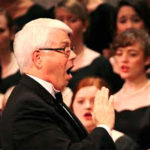WACO—The Black Gospel Music Restoration Project—a search-and-rescue mission launched by a Baylor University researcher to save little-known recordings from the Golden Age of black gospel—will become a permanent feature of the Smithsonian Institution’s National Museum of African American History & Culture, scheduled to open in 2015.
 Robert Darden, associate professor of journalism, public relations and new media at Baylor, has doggedly tracked down and restored the “fast-vanishing vinyl legacy” of American Black Gospel Music.The collection, managed and maintained by Baylor Libraries’ digital projects group, will be among materials displayed at the museum, according to museum officials and project founder Robert Darden, an associate professor of journalism, public relations and new media at Baylor.
Robert Darden, associate professor of journalism, public relations and new media at Baylor, has doggedly tracked down and restored the “fast-vanishing vinyl legacy” of American Black Gospel Music.The collection, managed and maintained by Baylor Libraries’ digital projects group, will be among materials displayed at the museum, according to museum officials and project founder Robert Darden, an associate professor of journalism, public relations and new media at Baylor.
“When we first conceived what would become the Black Gospel Music Restoration Project, we really had two goals in mind … both of which seemed impossibly distant and far-fetched at the time,” Darden said.
“One, we wanted to begin the never-ending process of identifying, acquiring, digitizing and cataloguing gospel music’s fast-vanishing vinyl legacy. I feel so blessed that we’re well on the way to accomplishing that goal. This is an ongoing process that I hope and pray continue long after I’m gone.
“The second goal/dream was to make this priceless, extraordinary music widely available. Working with the Smithsonian’s new National Museum of African American History & Culture will go a long way to making that second dream a reality.”
 Robert Darden interviews Deacon Reuben Burton of the gospel group The Victory Travelers in Chicago.While vintage albums by such legends as Mahalia Jackson are available on CDs, music by lesser-known artists such as the Spirit of Memphis were hard to find, as Darden discovered while writing his book People Get Ready! A New History of Black Gospel Music.
Robert Darden interviews Deacon Reuben Burton of the gospel group The Victory Travelers in Chicago.While vintage albums by such legends as Mahalia Jackson are available on CDs, music by lesser-known artists such as the Spirit of Memphis were hard to find, as Darden discovered while writing his book People Get Ready! A New History of Black Gospel Music.
From the 1940s through the 1970s, because of primitive technology and expense, it was hard for many musicians to make live recordings—usually 45rpm or 78rpm records, Darden said. A surprisingly large number of “B” sides of old 45s of gospel songs address the subject of civil rights, the Vietnam War and other social issues.
Darden and Dwandalyn Reece, the museum’s music and performing arts curator, view the recordings as an important addition to help museumgoers understand gospel’s contribution both to societal issues and spiritual life.
A 2005 op-ed article Darden wrote for The New York Times, in which he lamented the loss of many of the country’s recorded collections of black gospel music, sparked the project. That appeal generated a lead contribution from collector Charles M. Royce, whose gift funded equipment purchases and hiring the first audiovisual specialist. The project officially launched in 2008.
Sign up for our weekly edition and get all our headlines in your inbox on Thursdays
Project collaborators include Bob Marovich of Chicago, a gospel music collector and blogger, who had a packed walk-in closet holding more than 3,600 gospel 45s and 78s and more than 1,600 gospel LPs. He and Darden became friends via email shortly after the project began, and Darden credits much of the project’s success to Marovich’s generosity with his collection.
 Inspiration for the project came from Darden’s research for his book, People Get Ready! A New History of Black Gospel Music, published in 2004.Since then, Darden’s promotion, combined with the knowledge of Baylor librarians and the technical expertise of Baylor’s digital projects group, has resulted in a collection of nearly 8,500 “sides” digitized—LPs and 45s, primarily—with a sample of the collection available through Baylor on iTunes.
Inspiration for the project came from Darden’s research for his book, People Get Ready! A New History of Black Gospel Music, published in 2004.Since then, Darden’s promotion, combined with the knowledge of Baylor librarians and the technical expertise of Baylor’s digital projects group, has resulted in a collection of nearly 8,500 “sides” digitized—LPs and 45s, primarily—with a sample of the collection available through Baylor on iTunes.
The collection will be part of the Smithsonian’s Musical Crossroads exhibition to help tell the story of African-American music, from the arrival of the first Africans in America through the present.
In a story from the museum’s Tumblr blog, Reece said the recordings also may be used to highlight the regional diversity of early gospel music.
“Not all gospel recordings made during the pinnacle of gospel’s popularity were made on major labels,” she said. “Many were done in connection with local churches, and there are differences in style based on where these types of recordings were made.”
Pattie Orr, vice president for information technology and dean of university libraries at Baylor, said the project fits well with Baylor’s mission.
 “We were already expanding into digital preservation of print materials, building a center whose sole purpose was to take our print collections, digitize them for preservation and then share them with the world, where possible within copyright,” she said.
“We were already expanding into digital preservation of print materials, building a center whose sole purpose was to take our print collections, digitize them for preservation and then share them with the world, where possible within copyright,” she said.
“When Bob Darden was approached about preserving black sacred music, and he came to us, it was a natural fit. Instead of digitizing only print culture, this project blessed us with the opportunity to get into digital audio preservation—a challenge we embraced wholeheartedly and, now, with great success.
“We are preserving a phenomenon that is significant to American cultural history that will be valuable for future research.”
To listen to audio selections from the project, click here.














We seek to connect God’s story and God’s people around the world. To learn more about God’s story, click here.
Send comments and feedback to Eric Black, our editor. For comments to be published, please specify “letter to the editor.” Maximum length for publication is 300 words.